California shipping restrictions are different to many other states, and this is why it’s beneficial for companies and organizations that wish to send freight to or from California to be aware of the relevant regulations, rules, and restrictions. California is one of the most active states in terms of freight transportation and shipping. With an expansive network of highways and major ports, thousands of tons of commodities pass through the Golden State each year.
California has a reputation for being a forward-thinking state, and laws related to emissions and operating hours can make shipping freight into or out of the state more complex than other parts of the US. If you’re looking to ship products in California, this guide will provide in-depth information about California shipping restrictions and answer some of the most frequently asked questions.
California is one of the busiest states in terms of processing shipments and transporting goods. The roads are often scattered with trucks, carry commodities both intrastate and interstate. Statistics from the state’s Bureau of Transportation suggest that shipments originating in California represent:
California accounts for 10.7% of total U.S. shipments. Most commonly, freight that originates in California is bound for interstate locations. The most common destinations outside of California include Texas, Arizona, Washington, and New York. Statistics for inbound shipments suggest that freight is most likely to arrive from Texas, Oregon, Illinois, Utah, Arizona, and Nevada.
Are you shipping freight from Utah to California? Learn about this busy route.
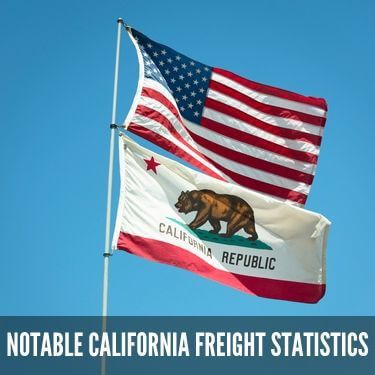
The most common types of commodities that are transported within the state of California include:
Transportation by truck is by far the most common means of delivering freight. Truck transportation accounts for 82.3% of the total weight and 68.2% of the total value of commodities. Most shipments originating in California travel less than 50 miles. Shipments from the manufacturing, wholesale trade, mining, and warehousing industries make up the majority of goods originating in California.
Are you shipping cars from California? Learn more about auto transport in the Golden State.
Companies that wish to ship freight in California should be aware of truckload specifications and regulations relating to the size and weight of vehicles. There are legal load guidelines in place, and trucking companies are required to adhere to the rules in order to transport goods legally and safely.
To carry freight in California without any additional permits, trucks must not be:
Weight restrictions also apply in California. The gross weight of the vehicle should not exceed 80,000 lbs. In addition, the weight applied to a single axle should not exceed 20,000 lbs and tandem axles must not weigh more than 34,000 lbs. The gross weight on a single wheel should not be over 10,500 lbs. The gross wheel weight restriction does not relate to vehicles carrying livestock.
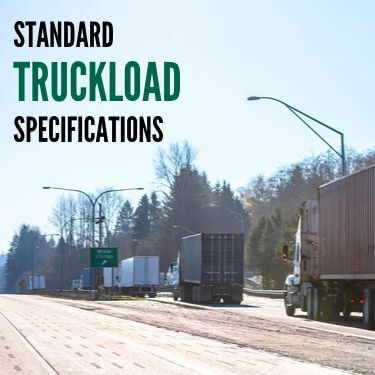
If a vehicle is carrying an abnormally large or heavy load, which doesn’t fit within the parameters listed above, it will be necessary to apply for a special permit for heavy haul shipments. In addition to obtaining a permit, transporters of heavy haulage will also need to explore pilot car regulations and travel time restrictions. There are specified hours of the day in some areas for heavy loads to travel to prevent traffic build-up during peak hours.
It’s important to note that the total load weight should factor in the weight of the vehicle and the shipment load.
If you're shipping an oversized load through or to California, we can help you. R+L Global Logistics is an expert in heavy haul trucking. We'll ensure that your freight isn't held up or taken due to non-compliance with California's strict guidelines.
The U.S. is one of the most significant producers of emissions in the world, and California is paving the way for cleaner air and a shift towards eco-friendly transportation. California has introduced laws and rules to try and lower emissions. Guidelines established by the California Air Resources Board (CARB) are now legally binding, and they cover commercial trucks and off-road vehicles. New emissions laws were brought in to maximize the chances of achieving ambitious environmental targets set out by the Federal Government. The Truck and Bus Regulation represents a major step forward in decreasing harmful emissions.
The Truck and Bus Regulation states that heavy-duty vehicles that travel on Californian roads must take steps to reduce toxic air contaminants, also known as TACs, from exhaust emissions. Research conducted by the CARB suggests that diesel emissions are linked to an elevated risk of cancer. By January 1st 2023, trucks and buses will be required to have new engines (2010 or later) to lower nitrogen oxide emissions and reduce particulate matter (PM).
To facilitate a seamless transition to the new regulations, from 2020, the California Department of Motor Vehicles will only register vehicles that are compliant.
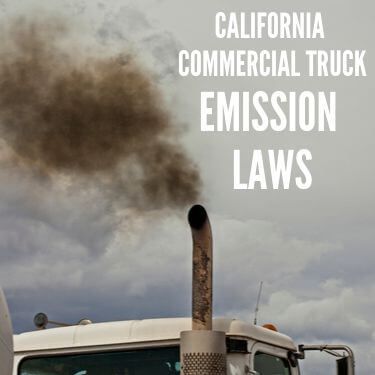
Truck emissions are a significant source of pollution, and the Truck and Bus Regulation is viewed as a crucial step forward by environmental campaigners. The aim is to lower hazardous emissions, to improve air quality, to reduce the risk of smog, and to protect the health of individuals, particularly those living in deprived areas of the state. This regulation forms part of the Diesel Risk Reduction Plan and the State Implementation Plan.
Need freight shipping from California to Texas? We have the services you need to stay compliant and arrive on time.
Carriers operating both within and outside of the state of California are required to ensure they have the relevant licenses and permits. The Motor Carrier Permit, or MCP, can be obtained from the California Department of Motor Vehicles. If a carrier is traveling intrastate and making journeys within California, this permit will suffice. If a carrier is traveling to California from another state, the permit will be required in addition to:
If you’re unsure whether you have the right documentation or permits for carrying goods either within or into California, you can contact the Department of Motor Vehicles. If you don’t already have a CA number, this can be obtained from the California Highway Patrol or the Motor Carrier Permit Operations Unit.
When shipping freight in California, it’s always wise to check permits and licenses in advance to prevent delays and penalties.
Want to learn more about shipping in California? Check out are article on freight shipping in Los Angeles.
The use of truck lanes in California is outlined in the California Vehicle Code (CVC). Under guidelines outlined in the code, certain vehicles must travel at reduced speeds. When making a journey in California, the following rules apply:
When traveling on the highways, trucks that fit the criteria must use designated lanes as advised in the CVC. Truck lanes should be used when open. Open lanes will be clearly marked with signs. If no signs are present, and truck lanes aren’t in use, those vehicles should use the other lanes of the highway, taking care to avoid the left hand lanes. Truck drivers are advised to stay within the right hand lanes, as close as possible to the edge of the highway. These rules do not apply for drivers taking a left turn or entering the highway via a slip road.
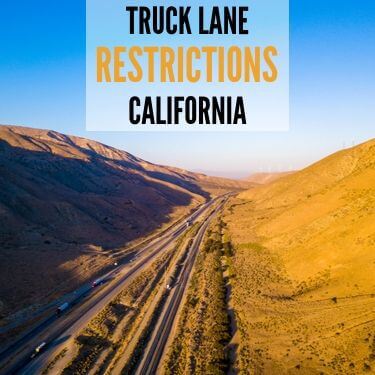
As well as designated truck lanes, drivers may also come across lanes for slow-moving vehicles. According to the CVC, any vehicle that is moving slower than the usual speed of traveling traffic should use the right hand lane whenever possible.
The use of truck lanes and guidelines related to lane use for slower-moving and heavier vehicles are designed to facilitate the free-flowing movement of traffic and prevent delays. The left hand lanes should generally be reserved for cars and faster moving traffic.
Truck-only lanes are designated highway passages for trucks and heavy-duty vehicles. These lanes should only be used by trucks. The primary aim of truck-only lanes is to separate trucks from other traffic, enabling cars and other lighter vehicles to travel at the designated speed limit for the highway.
Truck-only lanes are not commonplace in the US. In most states, trucks are required to use specific lanes, but these lanes can also be used by other vehicles. Typically, highway codes encourage trucks to stick to the right hand lanes of the highway, with cars occupying the left hand lanes.
There are currently two truck-only lanes in California. These include:
When truck-only lanes are in operation, and signs are displayed, trucks must use these facilities. Truck-only lane signs are black and white. It is not illegal for cars to travel in truck-only lanes, but car drivers are strongly advised to stay out of truck-only lanes. Advisory notices can usually be found on the highway, and they are green and white.
Feasibility studies conducted by the Southern California Association of Governments suggested that truck-only lanes were best suited to highways with heavy truck flow (where trucks account for more than 30% of the total volume of traffic), and roads with peak hours that see more than 1,800 vehicles traveling on each lane per hour and off-peak hours that see more than 1,200 vehicles traveling per lane per hour.
Weigh stations are scattered throughout the road network in California. If you’re delivering freight in California, it’s essential to be aware of weigh station rules, and to understand when you need to stop, and what to do once you arrive at a weigh station. Weigh stations may also be referred to as Commercial Vehicle Enforcement Facilities.
Guidelines related to weigh stations are outlined in the California Vehicle Code.
Under section 2813 of the CVC, all commercial vehicles must stop at a weigh station. A commercial vehicle is defined as:
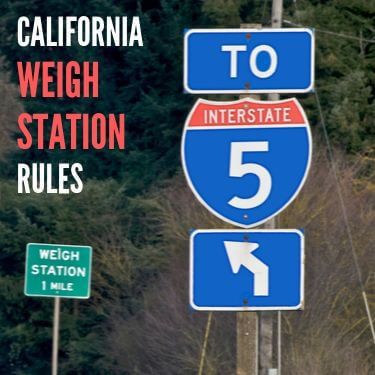
Other vehicles that may be required to stop at a weigh station include:
When you stop at a weigh station, the vehicle will be inspected by the California Highway Patrol. The vehicle will be checked based on:
Vehicles are required to stop when highway patrols are carrying out inspections and signs are clearly displayed, encouraging drivers to pull over at the next weigh station. If a weigh station is operational, there are signs directing drivers to stop, and you fail to submit the vehicle to inspection, this represents a misdemeanor.
Commercial trucks can often be seen stopping at weigh stations, but there are other vehicles that might also need to stop. These include pick-up trucks with a gross weight of over 11,500 lbs (laden) or over 8,001 lbs (unladen), pick-ups with cabs or crew beds, and rental trucks.
Weigh stations are usually located just off the main state highways and they are manned by California Highway Patrol. The aim of a Commercial Vehicle Enforcement Facility is to ensure drivers are not put at risk by overweight or unsafe vehicles. Weigh stations use static or weigh-in-motion scales to weigh vehicles quickly and effortlessly.
If you’re unsure whether or not you need to stop at a weigh station, the best thing to do is contact the California Highway Patrol.
The California Truck Network Map is an official government source, which outlines the truck routes in use in California. There are private guides available, but this source is regarded as the most accurate. The route lists available from Caltrans provide information about routes that are open to trucks and length restrictions. The district map is divided into 12 sections, each covering a different part of the state. Roads are marked according to the following key:
Green routes are open to California black trucks, as well as green STAA (Surface Transportation Assistance Act) trucks. Blue routes are also open to both types of trucks, and they usually feature advisory signs. Black-dashed routes are open to California black trucks. Yellow routes are also open to black trucks, but there are restrictions, which usually relate to the length of the vehicle. Red routes vary, and there are usually signs in place, which will inform you whether or not the road is open to trucks.
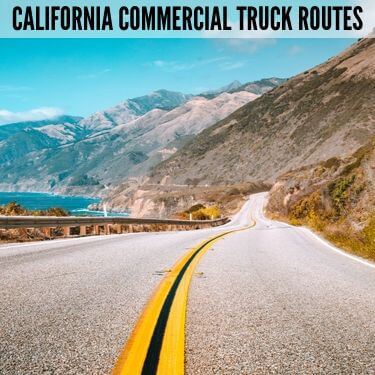
To find out which routes you can use in California, it’s wise to work through this 3-step process:
If you are traveling on Californian highways, it’s best to plan your route in advance and make sure that you have a clear idea of the routes and roads that are open to you.
Insurance is a legal requirement for companies operating commercial vehicles in California. If you run a fleet of trucks, for example, you should ensure that you have the relevant insurance cover in place. Insurance coverage is available for a wide range of commercial vehicles, including trucks used for short and long-haul journeys, tow trucks, and carriers that transport hazardous materials. There are two main types of commercial truck insurance:
In addition to these two essential forms of coverage for commercial ventures, it is also possible to incorporate extra features to provide more comprehensive, robust cover. Examples include worker’s compensation insurance, excess liability cover, mechanical breakdown insurance, and cargo cover.
The state of California specifies insurance requirements for different types of commercial vehicles, including:
If you drive a commercial truck in California, you must meet minimum requirements in terms of liability insurance. The amount of liability insurance you require will depend on where you drive, and what you are transporting. In cases where your journey takes place entirely within state borders, and the gross vehicle weight exceeds 10,000 lbs, you should be in possession of a CA Intrastate number and ensure you have liability insurance up to the value of:
This information fits in line with guidelines issued by the Federal Motor Carrier Safety Administration.
California state officials and the US Department of Transport stipulate that certain information is filed with your insurance policies. This will usually be taken care of by your insurance provider, and it ensures that you have all the relevant documentation and cover in place.
California differs to some states in that it doesn’t have a specified window for chain laws. There are no set dates that require drivers to carry chains with them. If the weather conditions are poor, and there are signs displayed advising drivers to carry chains, commercial vehicles, including all heavy-weight vehicles weighing at least 6,500 lbs, must be furnished with chains, which should be fitted to the tires to enhance grip. Chains help to lower the risk of skidding and sliding in slippery conditions. If there are signs on show, restrictions will be included. In some cases, depending on the weather, some vehicles, for example, a 4x4 with winter tires, may not be required to use tire chains.
In chain control areas in California, vehicles are permitted to travel, provided that they are equipped with link-tire or cable chains, sometimes referred to as tire traction devices. Tire traction devices are capable of increasing traction, and improving braking and cornering. Automatic traction devices, also known as ATDs, are increasingly commonplace. These devices are used for commercial trucks, emergency vehicles and buses, and they can be employed when additional traction is required. ATDs are legal in California, but drivers may be requested to carry traditional tire chains in addition.
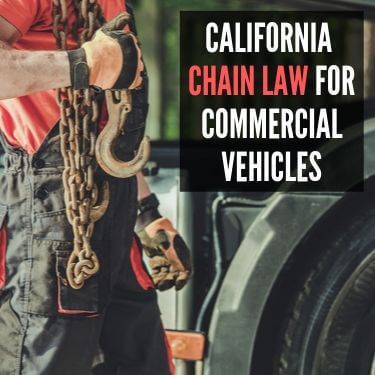
Chain requirements may vary according to the type of vehicle. For an 18-wheeler, which comprises a 3-axle tractor and a 2-axle semitrailer, the guidelines are as follows:
In some areas, vehicles that have either a double trailer or a 2-axle tractor may be prohibited from using specific routes. Most commonly, chains are required in the north of the state when using roads in more mountainous regions.
If the weather conditions are poor, check stations may be opened to screen trucks and ensure they have the relevant equipment to travel safely.
A commercial vehicle trip permit can be obtained for a vehicle, which is registered in a different state, with which California has a licensing reciprocity agreement. Permits can be purchased from the California Department of Motor Vehicles. The permit, which is also known as Reg 41, should be completed and dated by the operator in advance of the journey. The permit is:
The cost of the permit is $45 and it can be obtained from offices of the California Department of Motor Vehicles or at some truck stops.
Heavy haul regulations relate to vehicles that exceed normal truckload specifications. In California, a vehicle will be classed as heavy haul if the gross weight of the vehicle exceeds 80,000 lbs, the vehicle length exceeds 135-feet, or the width measures more than 14 feet.
If you’re planning to transport a heavy haul shipment, you’ll need to ensure you have the relevant permits. If the dimensions don’t fit within normal specifications, you’ll need additional documentation, and it may also be necessary to arrange a pilot car. In line with regulations set out by the California Department of Transportation, permits can be obtained for a single trip, a year, or for a continuous series of journeys. A heavy haul permit is valid for 5-7 days and it is issued on a per shipment basis.
It’s crucial to calculate the gross weight of the vehicle when determining whether or not a heavy haul permit is required. The gross weight will include the weight of the vehicle combined with the weight of the load.
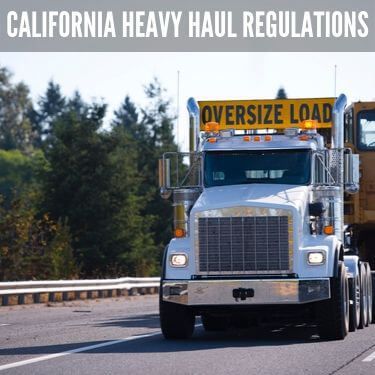
If you’re transporting heavy haulage, your truck should be fitted with the relevant safety lights and warning signs, for example, wide load, to alert other road users to your presence.
In addition to understanding regulations linked to oversized freight, it’s also important to be aware of rules associated with the transportation of animals. If you are carrying animals into the state of California, they must be properly vaccinated and you should have the relevant permits in line with guidelines set out by the California Department of Food and Agriculture (CDFA). There are restrictions in place governing the transportation of agricultural products. The state or country of origin can impact whether or not products like outdoor plants, fruits, vegetables, trees, and house plants can enter California. Further information is available from the CDFA or the Animal and Plant Health Inspection Service.
When carrying heavy or abnormal loads, there are time limits in place. Generally speaking, these include peak times close to major cities, for example, transportation is not permitted within the hours of 6-9 a.m. and 3-6 p.m. in Los Angeles.
In some cases, when transporting heavy haulage or carrying an abnormally-sized shipment, a pilot car is required. A pilot car is an escort, which accompanies the vehicle as it makes its way from Point A to Point B. Pilot cars are designed to provide a protective barrier between a long, wide, or heavy vehicle and flowing traffic, and to alert other drivers and road users to the presence of the vehicle. Typically, a pilot car will follow or precede the vehicle. The primary aim is to promote safety.
Pilot cars are required for vehicles traveling in California, which don’t fit the normal truckload specifications. If the vehicle is carrying a wide load, for example, a pilot car should be requested. The number of pilot cars required will depend on the dimensions of the vehicle and the route taken. On a green or blue route, for example, a vehicle with a width of over 14-feet will need 2 pilot cars. In this instance, one car will travel in front of the vehicle, with the other behind.
A pilot car route map is available to view on the Caltrans website. When using pilot cars, carriers must adhere with specified time frames for travel.
If you’re looking to ship freight to or from California, let R+L Global Logistics take the hassle out of haulage. With years of experience in intrastate, interstate, and global shipping and logistics, we’re confident we can provide you with a first-class, seamless shipping service. If you have shipments to send, we’ll do everything possible to make sure they arrive on time, every time.
We can help ship all kinds of California commodities. From shipping multiple cars from California to wine transportation services from California and everything in between, we can be your strategic partner.
At R+L Global Logistics, we understand the ins and outs of California shipping restrictions, and we can provide safe, swift solutions for businesses and organizations across a broad spectrum of industries. We provide a diverse range of freight, shipping and logistics services, and we aim to take the stress out of delivering shipments to and from California. If you’re keen to learn more, or you have questions or concerns about shipping within California, don’t hesitate to get in touch.
R+L Global Logistics
315 NE 14th St., Ocala, FL 34470